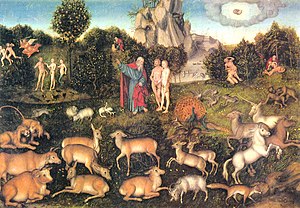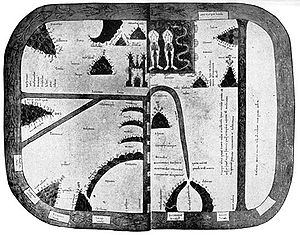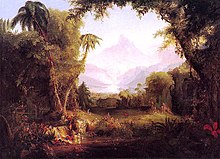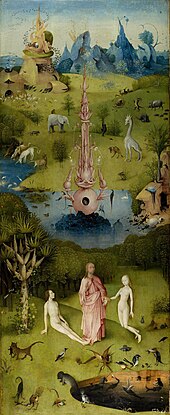Garden of Eden: Difference between revisions
→Location and nature: that doesn't seem to serve a purpose |
|||
| Line 43: | Line 43: | ||
===Lebanon=== |
===Lebanon=== |
||
Ezekiel 31 appears to identify Eden with Lebanon.<ref>{{harvnb|Stordalen|2000|p=164}}</ref> "[I]t appears that the Lebanon is an alternative placement in Phoenician myth (as in Ez 28,13, III.48) of the Garden of Eden",<ref>{{harvnb|Brown|2001|p=138}}</ref> and there are connections between paradise, the garden of Eden and the forests of Lebanon (possibly used symbolically) within prophetic writings.<ref>{{harvnb|Swarup|2006|p=185}}</ref> [[Edward Lipinski (orientalist)|Edward Lipinski]] and Peter Kyle McCarter have suggested that the [[Garden of the gods (Sumerian paradise)]], the oldest [[Sumerian]] version of the Garden of Eden, relates to a mountain sanctuary in the Lebanon and Anti-Lebanon ranges.<ref>{{harvnb|Smith|2009|p=61}}</ref> |
Ezekiel 31 appears to identify Eden with Lebanon.<ref>{{harvnb|Stordalen|2000|p=164}}</ref> "[I]t appears that the Lebanon is an alternative placement in Phoenician myth (as in Ez 28,13, III.48) of the Garden of Eden",<ref>{{harvnb|Brown|2001|p=138}}</ref> and there are connections between paradise, the garden of Eden and the forests of Lebanon (possibly used symbolically) within prophetic writings.<ref>{{harvnb|Swarup|2006|p=185}}</ref> [[Edward Lipinski (orientalist)|Edward Lipinski]] and Peter Kyle McCarter have suggested that the [[Garden of the gods (Sumerian paradise)]], the oldest [[Sumerian]] version of the Garden of Eden, relates to a mountain sanctuary in the Lebanon and Anti-Lebanon ranges.<ref>{{harvnb|Smith|2009|p=61}}</ref> |
||
===Jerusalem=== |
|||
Chanukah |
|||
===Other areas=== |
===Other areas=== |
||
Revision as of 18:29, 22 November 2012

The mythical Garden of Eden (Hebrew גַּן עֵדֶן, Gan ʿEdhen) is the biblical "garden of God", described most notably in the Book of Genesis (Genesis 2-3), but also mentioned, directly or indirectly, in Ezekiel, Isaiah and elsewhere in the Old Testament.[1] In the past, the favoured derivation of the name "Eden" was from the Akkadian edinnu, itself derived from a Sumerian word meaning "plain" or "steppe", but it is now believed to be more closely related to an Aramaic root meaning "fruitful, well-watered."[1]
The text of the Genesis garden-story is surrounded by uncertainties. Notable among them are: (1) whether the word "eden" means a steppe or plain, or instead means "delight" or some similar term; (2) whether the garden was in the east of Eden, or Eden itself was in the east, or whether "east" is not the correct word at all and the Hebrew means the garden was "of old"; (3) whether the river in Genesis 2:10 "follows from" or "rises in" Eden, and the relationship, if any, of the four rivers to each other; and (4) whether Cush, where one of the four rivers flows, means Ethiopia (in Africa) or Elam (just east of Mesopotamia).[2]
The Eden of Genesis has been variously located at the headwaters of the Tigris and Euphrates in northern Iraq, in Africa, and in the Persian Gulf. The Eden in Ezekiel, however, is unequivocally located in Lebanon. For many medieval writers, the image of the Garden of Eden also creates a location for human love and sexuality, often associated with the classic and medieval trope of the locus amoenus.[3]
Summary
Genesis 2:4-3:24

See Genesis 2-3
The Genesis creation narrative opens with God creating the first human, whom he places in the divine garden "in Eden in the east". God tasks the man to tend the garden, but forbids him to eat from the Tree of Knowledge of Good and Evil. God then forms a woman from a rib of the man to be a companion to the man. The first man and woman break God's command and eat the fruit of the forbidden tree, and God expels them from the garden to prevent them from eating of a second tree, the Tree of Life, which would give them god-like immortality as well as god-like wisdom; a cherub and a flaming sword at the gate bars their return.
Ezekiel and elsewhere
See Ezekiel 28:12-19
In Ezekiel 28:12-19 the prophet Ezekiel (the "son of man") sets down God's word against the king of Tyre: the king was the "seal of perfection", adorned with precious stones from the day of his creation, placed by God in the garden of Eden on the holy mountain as a guardian cherub. But the king sinned through wickedness and violence, and so he was driven out of the garden and thrown to the earth, where now he is consumed by God's fire: "All the nations who knew you are appalled at you, you have come to a horrible end and will be no more."
The "garden of God" is mentioned in Genesis 14, and the trees of the garden are mentioned in Ezekiel 31, and scattered passages from Ezekiel, Zechariah and the Psalms refer to trees and water in relation to the Temple without explicitly mentioning Eden.[4]
Additionally, in modern Jewish eschatology, it is believed that history will complete itself and the ultimate destination will be when all mankind returns to the Garden of Eden.[5]
Location and nature

Genesis 2-3 locates the garden with reference to four rivers and the regions they flow through:
Now a river flowed out of Eden to water the garden; and from there it divided and became four rivers. The name of the first is Pishon; it flows around the whole land of Havilah, where there is gold.[...] The name of the second river is Gihon; it flows around the whole land of Cush. The name of the third river is Tigris; it flows east of Assyria And the fourth river is the Euphrates.
"Kush" is often incorrectly translated as Ethiopia, which was also known as Cush, but in this case thought to be referring to Cossaea, a Greek name for Elam, immediately to the east of ancient Babylon, which, unlike Ethiopia, does lie within the region being described.[6]
Babylonian and Sumerian parallels

Sumerian mythology had a parallel to the Eden garden in Dilmun, the dwelling-place of the immortals where sickness and death were unknown.[7]
Lebanon
Ezekiel 31 appears to identify Eden with Lebanon.[8] "[I]t appears that the Lebanon is an alternative placement in Phoenician myth (as in Ez 28,13, III.48) of the Garden of Eden",[9] and there are connections between paradise, the garden of Eden and the forests of Lebanon (possibly used symbolically) within prophetic writings.[10] Edward Lipinski and Peter Kyle McCarter have suggested that the Garden of the gods (Sumerian paradise), the oldest Sumerian version of the Garden of Eden, relates to a mountain sanctuary in the Lebanon and Anti-Lebanon ranges.[11]
Other areas
Jackson County, Missouri, North America
For members of The Church of Jesus Christ of Latter-day Saints (also known as the Mormons or Latter Day Saints), the Garden of Eden is believed to have been located in present-day Jackson County, Missouri.[12]
Sri Lanka
Sri Pada, named after a footprint-like formation found near the summit of a conical mountain in Sri Lanka. The Buddhist tradition deems it to be the footprint of the Buddha, in Hindu tradition that of Shiva and in Muslim and Christian tradition that of Adam. Moreover, there are four rivers starting from this mountain.
From Eden to Paradise



After c.500 BC the Persian term "Paradise" (Hebrew פרדס, pardes), meaning a royal garden or hunting-park, gradually became a synonym for Eden. The word "pardes" occurs three times in the Old Testament, but always in contexts other than a connection with Eden: in the Song of Solomon iv. 13: "Thy plants are an orchard (pardes) of pomegranates, with pleasant fruits; camphire, with spikenard"; Ecclesiastes 2. 5: "I made me gardens and orchards (pardes), and I planted trees in them of all kind of fruits"; and in Nehemiah ii. 8: "And a letter unto Asaph the keeper of the king's orchard (pardes), that he may give me timber to make beams for the gates of the palace which appertained to the house, and for the wall of the city." In these examples pardes clearly means "orchard" or "park", but in the apocalyptic literature and in the Talmud, "paradise" gains its associations with the Garden of Eden and its heavenly prototype, and in the New Testament "paradise" becomes the realm of the blessed (as opposed to the realm of the cursed) among those who have already died, with literary Hellenistic influences.
The Greek Garden of the Hesperides was somewhat similar to the Christian concept of the Garden of Eden, and by the 16th century a larger intellectual association was made in the Cranach painting (see illustration at top). In this painting, only the action that takes place there identifies the setting as distinct from the Garden of the Hesperides, with its golden fruit.
In Jewish eschatology
In the rabbinic literatures of the Talmud and the Jewish Kabbalah,[14] the scholars agree that there are two types of spiritual places called Garden in Eden. The first is rather terrestrial, of abundant fertility and luxuriant vegetation, known as the "lower Gan Eden". The second is envisioned as being celestial, the habitation of righteous, Jewish and non-Jewish, immortal souls, known as the "higher Gan Eden". The Rabbanim differentiate between Gan and Eden. Adam is said to have dwelt only in the Gan. Whereas Eden is said never to be witnessed by any mortal eye.[15]
According to Jewish eschatology,[16][17] the "higher Gan Eden" is called the "Garden of Righteousness". It has been created since the beginning of the world, and will appear gloriously at the end of time. The righteous dwelling there will enjoy the sight of the heavenly Chayot carrying the throne of God. Each of the righteous will walk with God, who will lead them in a dance. Its Jewish and non-Jewish inhabitants are "clothed with garments of light and eternal life, and eat of the tree of life" (Enoch 58,3) near to God and His anointed ones.[15] This Jewish rabbinical concept of a "higher Gan Eden" is opposed by the Hebrew terms Gehinnom[18] and Sheol, figurative names for the place of spiritual purification for the wicked dead in Judaism, a place envisioned as being at the greatest possible distance from "heaven".[19]
In art
Garden of Eden motifs most frequently portrayed in illuminated manuscripts and paintings are the "Sleep of Adam" ("Creation of Eve"), the "Temptation of Eve" by the Serpent, the "Fall of Man" where Adam takes the fruit, and the "Expulsion". The idyll of "Naming Day in Eden" was less often depicted. Much of Milton's Paradise Lost occurs in the Garden of Eden. Michelangelo depicted a scene at the Garden of Eden in the Sistine Chapel ceiling.
See also
References
- ^ a b Cohen 2011, pp. 228–229
- ^ Marlowe 2000, p. 371
- ^ Curtius 1953, p. 200,n.31
- ^ Luttikhuizen 1999, p. 37
- ^ "End of Days". End of Days. Aish. Retrieved 1 May 2012.
- ^ Speiser, 1994.
- ^ Cohen 2011, p. 229
- ^ Stordalen 2000, p. 164
- ^ Brown 2001, p. 138
- ^ Swarup 2006, p. 185
- ^ Smith 2009, p. 61
- ^ Bruce A. Van Orden, “I Have a Question: What do we know about the location of the Garden of Eden?”, Ensign, Jan. 1994, 54–55
- ^ Gibson, Walter S. Hieronymus Bosch. New York: Thames and Hudson, 1973. p. 26. ISBN 0-500-20134-X
- ^ Gan Eden - JewishEncyclopedia; 02-22-2010.
- ^ a b ibidem.
- ^ Olam Ha-Ba - The Afterlife - JewFAQ.org; 02-22-2010.
- ^ Eshatology - JewishEncyclopedia; 02-22-2010.
- ^ "Gehinnom is the Hebrew name; Gehenna is Yiddish." Gehinnom - Judaism 101 websourced 02-10-2010.
- ^ "Gan Eden and Gehinnom". Jewfaq.org. Retrieved 2011-06-30.
Bibliography
- Brown, John Pairman (2001). Israel and Hellas, Volume 3. Walter de Gruyter.
{{cite book}}: Invalid|ref=harv(help) - Carr, David M. (2011). "The Garden of Eden Story". An Introduction to the Old Testament. John Wiley & Sons.
{{cite book}}: Invalid|ref=harv(help) - Cline, Eric H. (2009). Biblical archaeology. Oxford University Press.
{{cite book}}: Invalid|ref=harv(help) - Cohen, Chaim (2011). "Eden". In Berlin, Adele; Grossman, Maxine (eds.). The Oxford Dictionary of the Jewish Religion. Oxford University Press.
{{cite book}}: Invalid|ref=harv(help) - Curtius, Ernst Robert (1953). European Literature and the Latin Middle Ages. Princeton UP. ISBN 978-0-691-01899-7.
{{cite book}}: Unknown parameter|coauthors=ignored (|author=suggested) (help) - Marlowe, W. Creighton (2000). "Eden". In Freedman, David Noel (ed.). Eerdmans Dictionary of the Bible. Amsterdam University Press.
{{cite book}}: Invalid|ref=harv(help) - Noort, Ed (1999). "Gan-Eden in the context of the mythology of the Hebrew bible". In Luttikhuizen, Gerard P. (ed.). Paradise interpreted: representations of biblical paradise in Judaism and Christianity. Brill.
{{cite book}}: Invalid|ref=harv(help) - Smith, Mark S. (2009). "Introduction". In Pitard, Wayne T. (ed.). The Ugaritic Baal Cycle, volume II. BRILL.
{{cite book}}: Invalid|ref=harv(help) - Speiser, E.A. (1994). "The Rivers of Paradise". In Tsumura, D.T.; Hess, R.S. (eds.). I Studied Inscriptions from Before the Flood. Eisenbrauns.
{{cite book}}: Invalid|ref=harv(help) - Stordalen, Terje (2000). Echoes of Eden. Peeters.
{{cite book}}: Invalid|ref=harv(help) - Swarup, Paul (2006). The self-understanding of the Dead Sea Scrolls Community. Continuum.
{{cite book}}: Invalid|ref=harv(help) - Tigghelaar, Eibert J.C. (1999). "Eden and Paradise". In Luttikhuizen, Gerard P. (ed.). Paradise interpreted: representations of biblical paradise in Judaism and Christianity. Brill.
{{cite book}}: Invalid|ref=harv(help) - Tsumura, D.T (1994). "Genesis and ancient near eastern stories of flood and creation". In Tsumura, D.T.; Hess, R.S. (eds.). I studied inscriptions from before the flood. Eisenbrauns.
{{cite book}}: Invalid|ref=harv(help) - Walton, John H.; Matthews, Victor H.; Chavalas, Mark W., eds. (2000). The IVP Bible background commentary: Old Testament. InterVarsity Press.
{{cite book}}: Invalid|ref=harv(help) - Walton, John H. (2006). Ancient Near Eastern Thought and the Old Testament: Introducing the Conceptual World of the Hebrew Bible. Baker Academic. ISBN 0-8010-2750-0.
{{cite book}}: Invalid|ref=harv(help) - Welch, John Woodland (2009). The Sermon on the Mount in the light of the Temple. Ashgate.
{{cite book}}: Invalid|ref=harv(help) - Wright, J. Edward (2002). The Early History of Heaven. Oxford University Press.
{{cite book}}: Invalid|ref=harv(help) - Wright, J. Edward (2004). "Whither Elijah?". In Chazon, Esther G.; Clements, Ruth (eds.). Things revealed: studies in early Jewish and Christian literature in honor of Michael E. Stone. Brill.
{{cite book}}: Invalid|ref=harv(help) - Wyatt, Nick (2001). Space and Time in the Religious Life of the Near East. Sheffield University Press.
{{cite book}}: Invalid|ref=harv(help)
